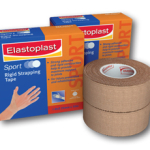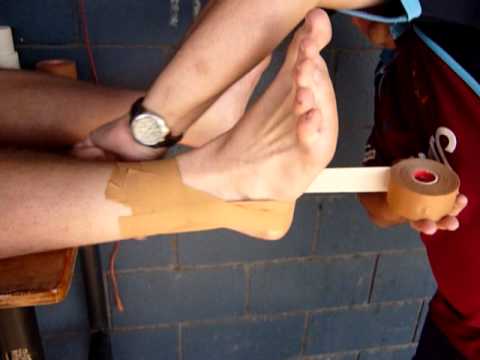Preventative taping is when the athlete tapes a joint, such as the ankle, in order to prevent injury from occurring. Athletes who use preventative taping often have a history of injury in the joint taped. The most common joints taped include: the ankle, the knee, the shoulder, and the wrist.
Taping used to prevent or treat injury is usually done using a rigid tape, such as Elastoplast, that does not stretch as this tape provides the best results for the prevention and treatment of injury. The benefits of kinesiology tape is not discussed on pdhpe.net because the evidence at the moment says that there is little if any benefit, as it tends to be worn more for aesthetics than injury prevention or performance benefits.
Preventative taping works by providing feedback to the athlete by pulling not the skin when the tap is stretched, providing a sensation. This sensation provides feedback to the athlete to stimulate the muscles around the joint and to reduce the movement in order to prevent injury.
In addition to this, preventative taping also works as a placebo. It allows the athlete to be confident in their movements, which helps in skilled athletes is biomechanically efficient, making them less likely to suffer injury.
Evaluate the role taping plays in the prevention of injury
Taping plays a very useful role in the prevention of injury. A systematic review published in The Journal of Science and Medicine in Sport found that ankle sprains decreased by ~70% when preventative taping was used.[1] This significantly increases the wellbeing of the athlete especially when ankle sprains account for 10-28% of sports injuries.
Most studies conducted focus on re-injury in athletes with a history of injury. However, the few studies that look solely at preventing injury have found that taping can reduce the injury rate by almost 50%. [2]
However, taping does have its down side. Long term taping can lead the athlete to becoming reliant upon the tape to provide the support for the joint. Long term taping can also decrease stabilising muscle strength and weaken the joint. For this reason taping should be used as a short term prophylactic (preventative) measure.
Other issues with taping include irritating the skin and reducing the athlete’s proprioception. That is, reducing their ability to know where their body is and when to adjust it in response to the environment or internal forces. This reenforces the idea that taping is used for short periods of time when returning from injury, and not as a continual preventative.
[1] Janine Margarita R. Dizon and Josephine Joy B. Reyes. (2010) “A systematic review on the effectiveness of external ankle supports in the prevention of inversion ankle sprains among elite and recreational players.” The Journal of Science and Medicine in Sport 13:3 pp 309–317.
[2] See references in the last paragraph here.

